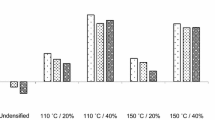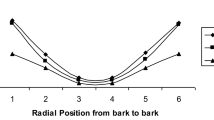Abstract
To resolve degradation problems of timber structures, analysis of the development of a fungal attack on structural timber is important. The progression of wood decay especially that of structural timber is not always uniform and reduces strength locally. Therefore, the strength profile is important in estimating the strength of decayed wood. In this study, Sitka spruce (20 mm × 20 mm × 100 mm (longitudinal direction)) was exposed to brown- and white-rot fungi for 3 to 15 weeks from the end surface. After decay, mass profiles of an oven-dried specimen were obtained by X-ray densitometry, and specimens for compressive and tensile tests were cut from the decayed wood to determine both compressive and tensile strength distribution profiles in the longitudinal direction. Except for some results of the tensile strength, after 3 weeks treatment with brown-rot fungus, both strength and mass were reduced. For the same decrease in mass, the tensile strength was reduced more by the brown-rot fungus than by the white-rot fungus, whereas the results for compression strength were almost the same for the two fungi. The results suggested that it is possible to estimate the strength loss of the decayed wood from the mass profile.










Similar content being viewed by others
References
Bouslimi B, Koubaa A, Bergeron Y (2014) Effects of biodegradation by brown-rot decay on selected wood properties in eastern white cedar (Thuja occidentalis L.). Int Biodeterior Biodegrad 87:87–98
Brischke C, Welzbacher CR, Huckfeldt T (2008) Influence of fungal decay by different basidiomycetes on the structural integrity of Norway spruce wood. Holz Roh Werkst 66:433–438
Curling SF, Clausen CA, Winandy JR (2002) Experimental method to quantify progressive stages of decay of wood by basidiomycete fungi. Int Biodeterior Biodegrad 49:13–19
Forest Products Society (2011) Wood handbook: wood as an engineering material. Madison, USA
Gonzalez JM, Morrell JJ (2012) Effects of environmental factors on decay rates of selected white- and brown-rot fungi. Wood Fiber Sci 44:343–356
Goodell B (2003) Brown-rot fungal degradation of Wood: our evolving view. Wood deterioration and preservation. In: Goodell B, Nicholas D, Schultz T (eds) Advances in our changing world. ACS Symposium Series 845. American Chemical Society, Washington, pp 97–118
Green B, Jones PD, Nicholas DD, Schimleck LR, Shmulsky R (2011) Non-destructive assessment of Pinus spp. wafers subjected to Gloeophyllum trabeum in soil block decay tests by diffuse reflectance near infrared spectroscopy. Wood Sci Technol 45:583–595
Japanese Industrial Standard Committee JIS Z 2101 (2009) Methods of tests for wood
Kennedy RW, Ifju G (1962) Applications of microtensile testing to thin wood sections. Tappi 45:725–733
Maeda K, Ohta M, Momohara I (2011) Analysis of decay progress anisotropy by X-ray computer tomography. Pro Ligno 7:18–25
Messner K, Fackler K, Lamaipis P, Gindl W, Srebotnik E, Watanabe T (2003) Overview of white-rot research: where we are today. In: Goodell B, Nicholas DD, Schultz TP (eds) Wood deterioration and preservation. Advances in our changing world. American Chemical Society, Washington, Symposium Series 845, pp 73–96
Przewloka SR, Crawford DM, Rammer DR, Buckner DL, Woodward BM, Li G, Nicholas DD (2008) Assessment of biodeterioration for the screening of new wood preservatives: Calculation of stiffness loss in rapid decay testing. Holzforschung 62:270–276
Schmidt O (2006) Wood and tree fungi: biology, damage, protection, and use. Springer, Berlin
Smith I, Landis E, Gong M (2003) Fracture and fatigue in wood. Wiley, New York
Venäläinen M, Partanen H, Harju A (2014) The strength loss of Scots pine timber in an accelerated soil contact test. Int Biodeterior Biodegrad 86:150–152
Wilcox WW (1978) Review of literature on the effects of early stages of decay on wood strength. Wood Fiber 9:252–257
Author information
Authors and Affiliations
Corresponding author
Rights and permissions
About this article
Cite this article
Maeda, K., Ohta, M. & Momohara, I. Relationship between the mass profile and the strength property profile of decayed wood. Wood Sci Technol 49, 331–344 (2015). https://doi.org/10.1007/s00226-014-0696-2
Received:
Published:
Issue Date:
DOI: https://doi.org/10.1007/s00226-014-0696-2




